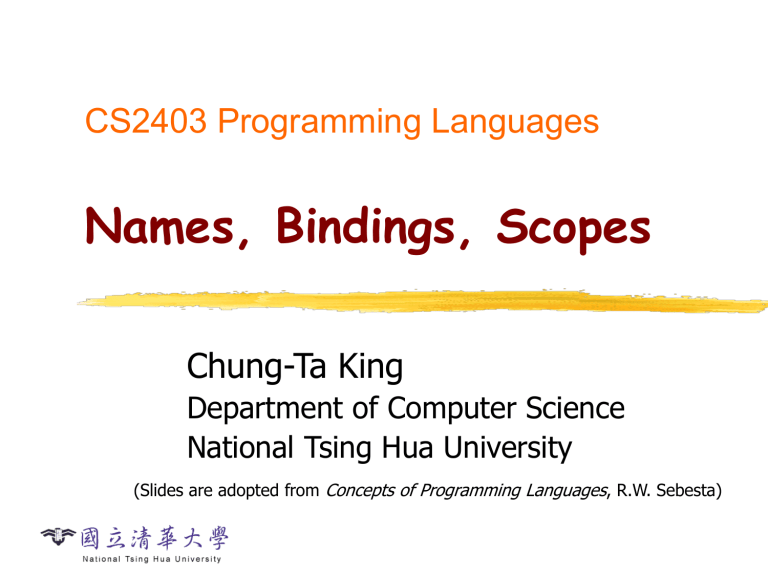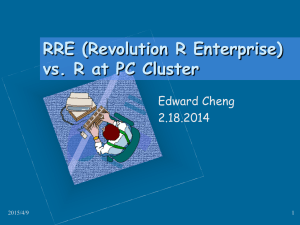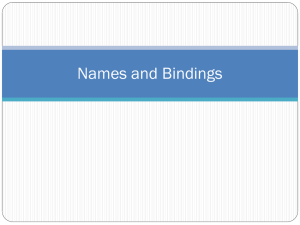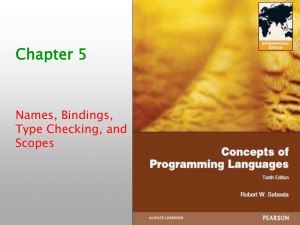PPT

CS2403 Programming Languages
Names, Bindings, Scopes
Chung-Ta King
Department of Computer Science
National Tsing Hua University
(Slides are adopted from Concepts of Programming Languages , R.W. Sebesta)
The Concept of Variables
What do x = 1 ; and x = x + 1; mean?
“=“ is not the equal sign of mathematics!
“x=1” does not mean “x is one” !
“x” is the name of a variable; refer to a variable
A variable is an abstraction of a memory cell
“x” is an identifier (name) refers to a location where certain values can be stored.
1
Imperative Lang. and von Neumann
Imperative languages are abstractions of von
Neumann architecture
Key components of von Neumann architecture:
Memory: store data and instructions
Processor: do operations to modify memory contents
Imperative language abstractions:
Variables memory cells
Expressions CPU executions
Memory
Processor
2
Roadmap
Ch. 1
Ch. 2
Ch. 3
Ch. 4
Ch. 5
Classification of languages
What make a “good” language?
Evolution of languages
How to define languages?
How to compile and translate programs?
Variables in languages
Ch. 7 Statements and program constructs in languages
Ch. 15 Functional and logic languages
3
Programmers’ View of Memory
int i,a[100]; void foo()
{ int i,j;
.. = j; i = ..;
}
• How variables are defined?
• How are they associated with storage?
i j i a
OS
Memory
Processor
(virtual) Memory
4
General Memory Layout
Address
$sp (stack
Pointer)
Stack
Space for saved procedure information int i,a[100]; void foo()
{ int i,j,*p;
.. = j; i = ..; p=malloc();
}
0
Heap
Static
Code
Explicitly created space, e.g., malloc()
Static or global variables, declared once per program
Program code
5
Overview
Study fundamental semantic issues of variables:
Attributes of variables (Sec. 5.1, 5.2, 5.3)
Name, value, type, address, lifetime, scope
Binding of variables (Sec. 5.4)
Scope and lifetime (Sec. 5.5, 5.6)
Referencing environments (Sec. 5.7)
Named constants (Sec. 5.8)
6
Variable Attributes: Name, Value
Name: also called
identifier
Length:
Most modern PL do not impose a limit
Connectors: e.g., underscore “_”
Model PL prefer camel notation, e.g., MyStack
Case sensitivity:
C, C++, and Java names are case sensitive
Names that look alike are different: rose , ROSE
Value:
The contents of the location with which the variable is associated
7
Variable Attributes: Type
Type:
Determines (1) the range of values that the variable can store; and (2) the set of operations that can be performed for values of that type
Uses of type system: error detection through type checking, program modularization, documentation
Can a variable have different types at different times?
Are two given types equivalent?
What happen when two variables of different types operate together?
Type will be discussed in length in next chapter
8
Variable Attributes: Address
Which address is variable i bound?
What if foo() is in recursion?
Which binding is visible in which part of the code?
For how long does a binding last?
Binding and lifetime int i,a[100]; void foo()
{ int i,j;
.. = j; i = ..;
} void bar()
{ int j;
.. = j; i = ..;
}
9
Overview
Study fundamental semantic issues of variables:
Attributes of variables (Sec. 5.1, 5.2, 5.3)
Name, value, type, address, lifetime, scope
Binding of variables (Sec. 5.4)
Storage Binding
Scope and lifetime (Sec. 5.5, 5.6)
Referencing environments (Sec. 5.7)
Named constants (Sec. 5.8)
10
The Concept of Binding
Binding:
an association, e.g. between a variable and its storage or its type
Possible binding times
Language design time: bind operator symbols to operations
Language implementation time: bind floating point type to a representation
Compile time: bind a variable to a type in C or Java
Load time: bind a FORTRAN 77 variable to a memory cell (or a C static variable)
Runtime: bind a local variable to a memory in stack
11
Static and Dynamic Binding
A binding is
static
program execution if it first occurs before run time and remains unchanged throughout
A binding is
dynamic
if it first occurs during execution or can change during execution int i,a[100]; void foo()
{ int i,j;
.. = j; i = ..;
}
12
Storage Bindings and Lifetime
Storage binding:
Allocation : get a cell from some pool of available cells
Deallocation : put a cell back into the pool
The
lifetime
of a variable is the time during which it is bound to a particular memory cell
Starts when a variable is bound to a specific cell and ends when it is unbound
Four categories for scalar variables according to lifetimes: static, stack-dynamic, explicit-heapdynamic, implicit heap-dynamic
13
Static Variables
Bound to memory cells before execution begins and remains throughout execution, e.g., all
FORTRAN 77, C static and global variables
Advantages:
Efficiency (direct addressing, no runtime allocation overhead), for globally accessible variables, historysensitive subprogram support
Disadvantage:
Lack of flexibility (no recursion), no sharing of storage among variables
Size of data objects must be known at compile time
Data structures cannot be created dynamically
14
Static Memory Model Cannot
Support Recursion
15
Stack-dynamic Variables
Storage bindings are created when declaration statements are elaborated at runtime
If scalar, all attributes except address are statically bound, e.g., local variables in C subprograms and
Java methods, allocated from the runtime stack
Advantage:
Allows recursion; conserves storage by all subprog.
Disadvantages:
Overhead of allocation and deallocation
Subprograms cannot be history sensitive
Inefficient references (indirect addressing)
16
Stack-dynamic Variables
17
Explicit Heap-dynamic Variables
Heap: a section of virtual address space reserved for dynamic memory allocation
Allocated and deallocated (in heap) by explicit directives or operators, specified by the programmer, which take effect during execution
Referenced through pointers or references, e.g. dynamic objects in C++ (via new and delete )
Static type binding, dynamic storage binding
Explicit or implicit deallocation (garbage collection)
18
Explicit Heap-dynamic Variables
Person *p; p=(Person *) malloc(sizeof Person); p->name = “Mike”; p->age = 40; free(p);
Java objects are explicit heap-dynamic variable
implicit garbage collection (no free or delete)
Advantage: can construct dynamic structures
Disadvantage: inefficient, unreliable, heap management cost
19
Explicit Heap-dynamic Variables
Implicit Heap-dynamic Variables
Allocation and deallocation caused by assignment statements, regardless of what the variable was previously used for
All variables in APL; all strings and arrays in Perl and
JavaScript
Advantage: flexibility
Disadvantages:
Runtime overhead for maintaining dynamic attributes
Loss of error detection by compiler
21
Overview
Study fundamental semantic issues of variables:
Attributes of variables (Sec. 5.1, 5.2, 5.3)
Binding of variables (Sec. 5.4)
Scope and lifetime (Sec. 5.5, 5.6)
Referencing environments (Sec. 5.7)
Named constants (Sec. 5.8)
22
Why Scope?
Given multiple bindings of a of this name refer to?
single name
, how do we know which binding does an occurrence
23
Scope
The
scope
of a variable is the range of statements over which it is visible
A variable is visible in a statement if it can be referenced in that statement
The
nonlocal
variables of a program unit are those that are visible but not declared there
The
scope rules
of a language determine how a reference to a name is associated with a variable and its declaration
24
Scope
Scope of a binding (declaration)
The region of the program maintained over which the binding is
25
Static Scope
Scope of a variable can be statically determined
Based on program text, a spatial concept
To connect a name reference to a variable, you
(or the compiler) must find the declaration
First search locally, then in increasingly larger enclosing scopes, until one is found for the given name, or an undeclared variable error
26
Static Scope
Variables can be hidden from a unit by having a
"closer" variable with the same name
C++ and Ada allow access to "hidden" variables: unit.name (in Ada) class_name::name (in C++)
Block: a method of creating new static scopes inside program units (from ALGOL 60)
e.g.: C and C++ in any compound statement for (...) { int index;
...
}
27
An Example of Block Scope in C
28
Dynamic Scope
Based on calling sequences of program units, not their textual layout (temporal versus spatial)
Can only be determined at run time
References to variables are connected to declarations by searching back through the chain of subprogram calls that forced execution to this point
29
Scope Example
MAIN
- declaration of x
SUB1
- declaration of x
...
call SUB2
...
SUB2
...
- reference to x
...
...
call SUB1
…
MAIN calls SUB1
SUB1 calls SUB2
SUB2 uses x
Static scoping:
Reference to x in SUB2 is to MAIN's x
Dynamic scoping:
Reference to x in SUB2 is to SUB1's x
30
Static vs. Dynamic Scoping
31
Evaluation of Dynamic Scope
Advantage:
Convenience (no need to pass parameters from caller to callee)
Disadvantage:
Local variables of an active subprogram are visible to any other active subprograms reliability
Cannot statically type check references to nonlocals
Poor readability
Longer accesses to nonlocal variables
32
Scope and Lifetime
Scope and lifetime are sometimes closely related, but are different concepts
Ex.: a static variable in a C or C++ function
Scope is static and local to the function
Lifetime extends over entire execution of program
Ex.: subprogram calls void printheader() { … } void compute() { int sum; … printheader();
//scope vs lifetime of sum
}
33
Overview
Study fundamental semantic issues of variables:
Attributes of variables (Sec. 5.1, 5.2, 5.3)
Binding of variables (Sec. 5.4)
Type (Sec. 5.5, 5.6, 5.7)
Scope and lifetime (Sec. 5.8, 5.9)
Referencing environments (Sec. 5.10)
Named constants (Sec. 5.11)
34
Referencing Environments
Referencing environment
of a statement is the collection of all names visible to the statement
In a static-scoped language, it is the local variables plus all of the visible variables in all of the enclosing scopes
In a dynamic-scoped language, the referencing environment is the local variables plus all visible variables in all active subprograms
A subprogram is active has not yet terminated if its execution has begun but
35
Referencing Environments
36
Named Constants
A
named constant
is a variable that is bound to a value only once, when it is bound to storage
Advantages: readability, modifiability, can be used to parameterize programs
Binding of values to named constants can be static (called
manifest constants
) or dynamic
FORTRAN 90: only constant-valued expressions
Ada, C++, Java: expressions of any kind
The binding of a variable to a value at the time it is bound to storage is called
initialization
Often done on declaration statement
37
Summary
Variables are abstractions for memory cells of the computer and are characterized by name, address, value, type, lifetime, scope
Binding is the association of attributes with program entities: type and storage binding
Scope determines the visibility of variables in a statement
38








